
Datadog (DDOG)
Datadog is an amazing business. Its blend of fast sales growth, robust unit economics, and superb prospects makes it a coveted asset.― StockStory Analyst Team
1. News
2. Summary
Why We Like Datadog
Named after a database the founders had to painstakingly look after at their previous company, Datadog (NASDAQ:DDOG) provides a software platform that helps organizations monitor and secure their cloud applications, infrastructure, and services.
- Market share has increased as its 42.9% annual revenue growth over the last five years was exceptional
- ARR growth averaged 26.5% over the last year, showing customers are willing to take multi-year bets on its software
- Well-designed software integrates seamlessly with other workflows, enabling swift payback periods on marketing expenses and customer growth at scale


Datadog is a standout company. The valuation looks reasonable in light of its quality, and we think now is a favorable time to invest in the stock.
Why Is Now The Time To Buy Datadog?
Why Is Now The Time To Buy Datadog?
Datadog is trading at $155.38 per share, or 14.5x forward price-to-sales. Most companies in the software sector may feature a cheaper multiple, but we think Datadog is priced fairly given its fundamentals.
By definition, where you buy a stock impacts returns. Still, our extensive analysis shows that investors should worry much more about business quality than entry price if the ultimate goal is long-term returns.
3. Datadog (DDOG) Research Report: Q3 CY2025 Update
Cloud monitoring platform Datadog (NASDAQ:DDOG) beat Wall Street’s revenue expectations in Q3 CY2025, with sales up 28.4% year on year to $885.7 million. On top of that, next quarter’s revenue guidance ($914 million at the midpoint) was surprisingly good and 3.2% above what analysts were expecting. Its non-GAAP profit of $0.55 per share was 20.4% above analysts’ consensus estimates.
Datadog (DDOG) Q3 CY2025 Highlights:
- Revenue: $885.7 million vs analyst estimates of $852.4 million (28.4% year-on-year growth, 3.9% beat)
- Adjusted EPS: $0.55 vs analyst estimates of $0.46 (20.4% beat)
- Adjusted Operating Income: $207.4 million vs analyst estimates of $179.4 million (23.4% margin, 15.6% beat)
- Revenue Guidance for Q4 CY2025 is $914 million at the midpoint, above analyst estimates of $885.7 million
- Management raised its full-year Adjusted EPS guidance to $2.01 at the midpoint, a 10.7% increase
- Operating Margin: -0.7%, down from 2.9% in the same quarter last year
- Free Cash Flow Margin: 24.2%, up from 20% in the previous quarter
- Customers: 4,060 customers paying more than $100,000 annually
- Billings: $892.6 million at quarter end, up 29.6% year on year
- Market Capitalization: $54.05 billion
Company Overview
Named after a database the founders had to painstakingly look after at their previous company, Datadog (NASDAQ:DDOG) provides a software platform that helps organizations monitor and secure their cloud applications, infrastructure, and services.
Datadog's platform integrates multiple monitoring functions that were traditionally separate products, including infrastructure monitoring, application performance monitoring, log management, and security tools. This integration allows engineering, operations, and security teams to work from a single dashboard rather than switching between different tools. The platform collects and analyzes trillions of data points daily through a lightweight agent installed on servers, containers, and cloud services.
For example, when an e-commerce company experiences a slowdown in their checkout process, Datadog can simultaneously track server performance, application code efficiency, database queries, and user experience metrics to quickly identify the root cause—whether it's an overloaded database, inefficient code, or network bottleneck.
Datadog generates revenue through subscription-based pricing, with customers paying based on the number of hosts monitored, data volume processed, and which products they use. The company operates on a land-and-expand model, where customers often start with one product and gradually adopt additional offerings. Customers include organizations of all sizes across industries, from tech startups to large enterprises, all seeking better visibility into increasingly complex cloud environments.
The platform supports more than 700 integrations with popular services and technologies from AWS, Microsoft Azure, Google Cloud, Kubernetes, and many others, making it adaptable to diverse technology stacks.
4. Cloud Monitoring
Software is eating the world, increasing organizations’ reliance on digital-only solutions. As more workloads and applications move to the cloud, the reliability of the underlying cloud infrastructure becomes ever more critical and ever more complex. To solve this challenge, companies and their engineering teams have turned to a range of cloud monitoring tools that provide them with the visibility to troubleshoot issues in real-time.
Datadog competes with infrastructure monitoring vendors like SolarWinds and IBM, application performance monitoring companies such as New Relic and Dynatrace, log management providers Splunk and Elastic, and cloud providers' native monitoring solutions from AWS, Microsoft Azure, and Google Cloud.
5. Revenue Growth
A company’s long-term performance is an indicator of its overall quality. Any business can put up a good quarter or two, but many enduring ones grow for years. Thankfully, Datadog’s 42.9% annualized revenue growth over the last five years was incredible. Its growth surpassed the average software company and shows its offerings resonate with customers, a great starting point for our analysis.
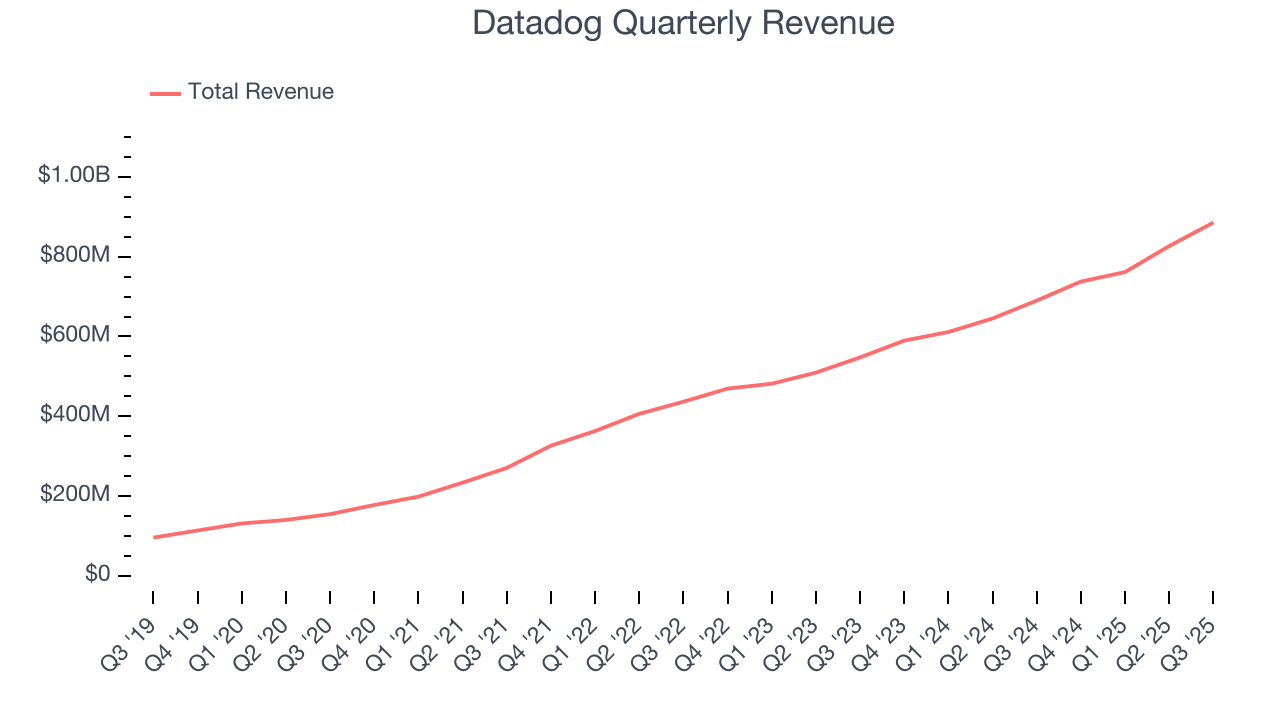
We at StockStory place the most emphasis on long-term growth, but within software, a half-decade historical view may miss recent innovations or disruptive industry trends. Datadog’s annualized revenue growth of 26.5% over the last two years is below its five-year trend, but we still think the results suggest healthy demand. 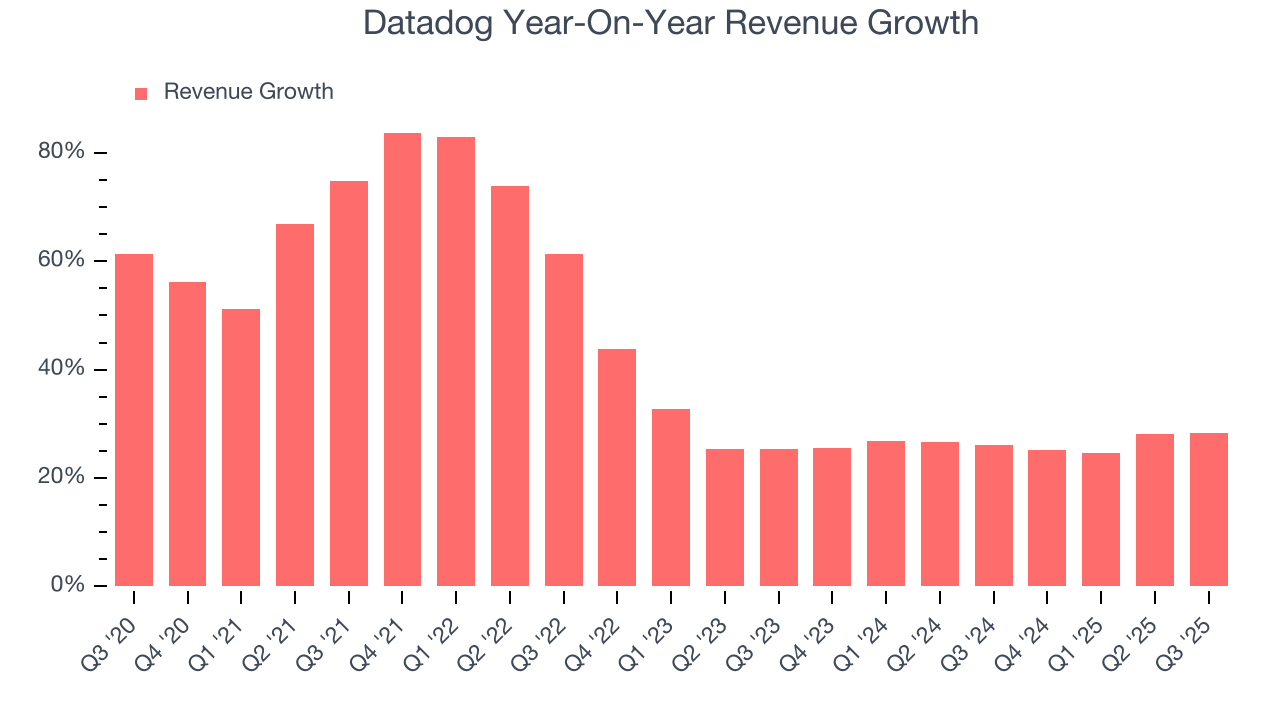
This quarter, Datadog reported robust year-on-year revenue growth of 28.4%, and its $885.7 million of revenue topped Wall Street estimates by 3.9%. Company management is currently guiding for a 23.9% year-on-year increase in sales next quarter.
Looking further ahead, sell-side analysts expect revenue to grow 18.2% over the next 12 months, a deceleration versus the last two years. Still, this projection is admirable and implies the market sees success for its products and services.
6. Billings
Billings is a non-GAAP metric that is often called “cash revenue” because it shows how much money the company has collected from customers in a certain period. This is different from revenue, which must be recognized in pieces over the length of a contract.
Datadog’s billings punched in at $892.6 million in Q3, and over the last four quarters, its growth was fantastic as it averaged 26% year-on-year increases. This performance aligned with its total sales growth, indicating robust customer demand. The high level of cash collected from customers also enhances liquidity and provides a solid foundation for future investments and growth. 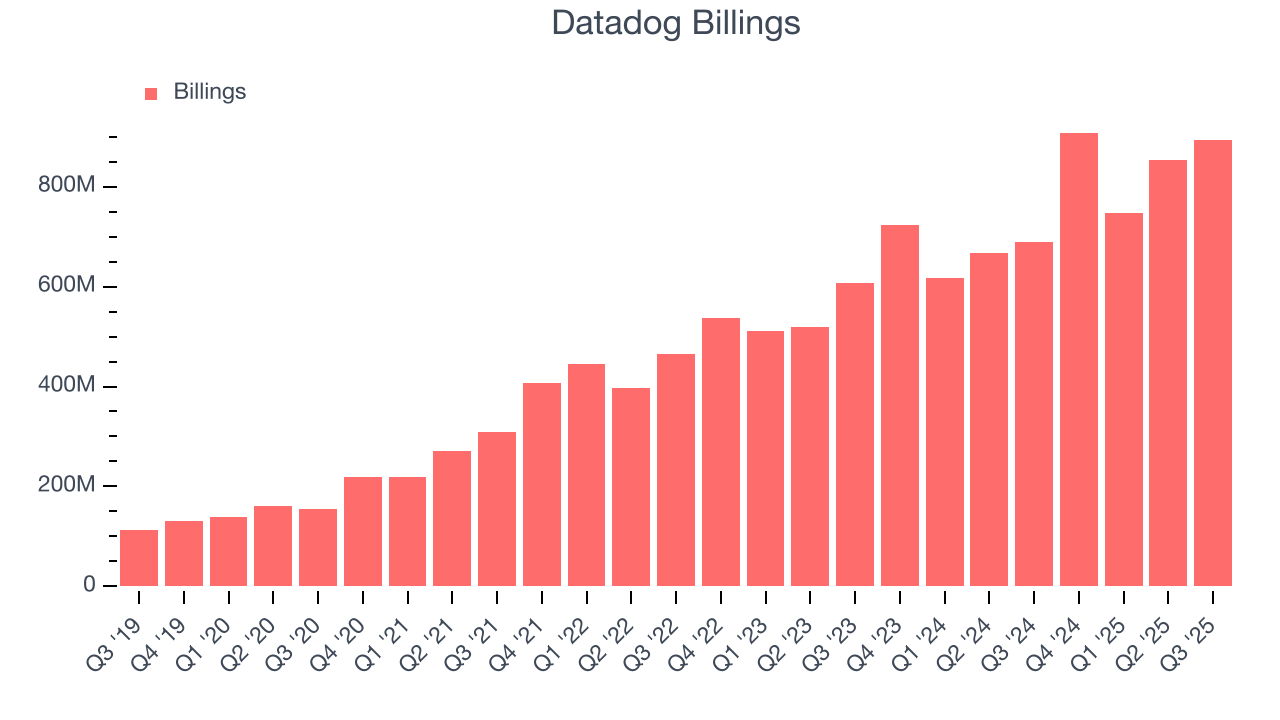
7. Enterprise Customer Base
This quarter, Datadog reported 4,060 enterprise customers paying more than $100,000 annually, an increase of 210 from the previous quarter. That’s quite a bit more contract wins than last quarter and quite a bit above what we’ve observed over the previous year. Shareholders should take this as an indication that Datadog’s go-to-market strategy is working well.
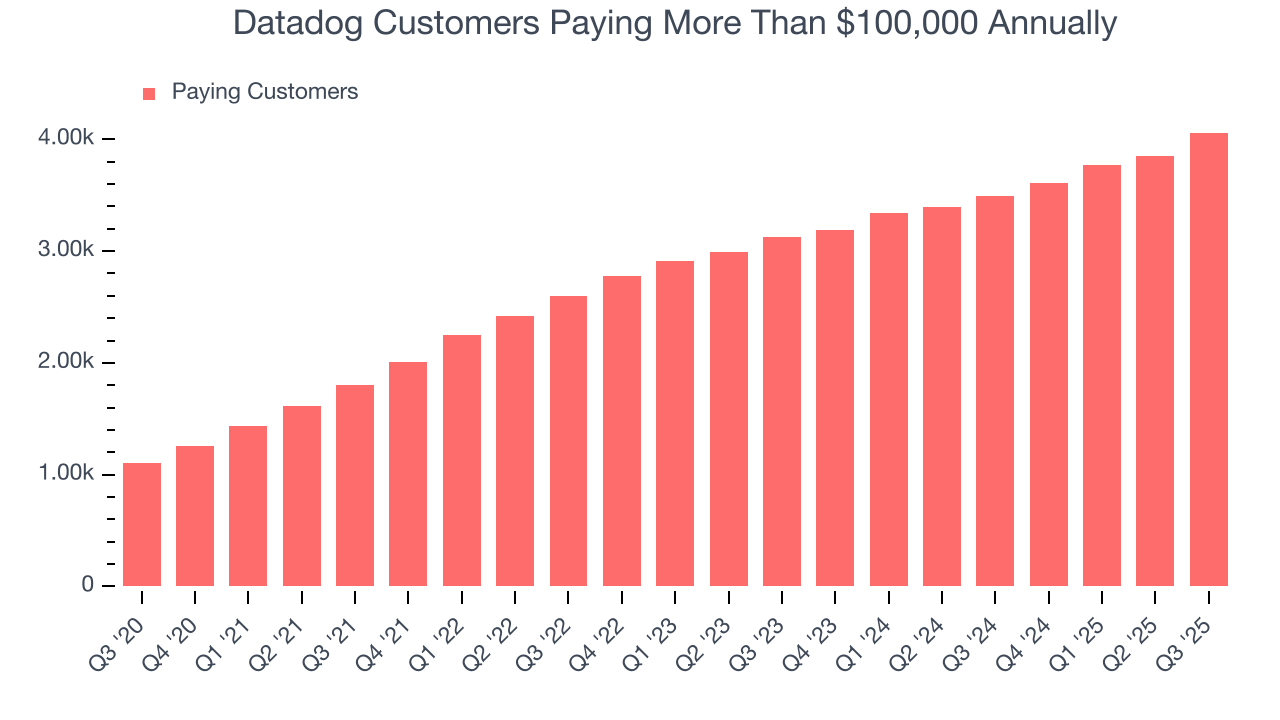
8. Customer Acquisition Efficiency
The customer acquisition cost (CAC) payback period measures the months a company needs to recoup the money spent on acquiring a new customer. This metric helps assess how quickly a business can break even on its sales and marketing investments.
Datadog is extremely efficient at acquiring new customers, and its CAC payback period checked in at 18.7 months this quarter. The company’s rapid recovery of its customer acquisition costs indicates it has a highly differentiated product offering and a strong brand reputation. These dynamics give Datadog more resources to pursue new product initiatives while maintaining the flexibility to increase its sales and marketing investments. 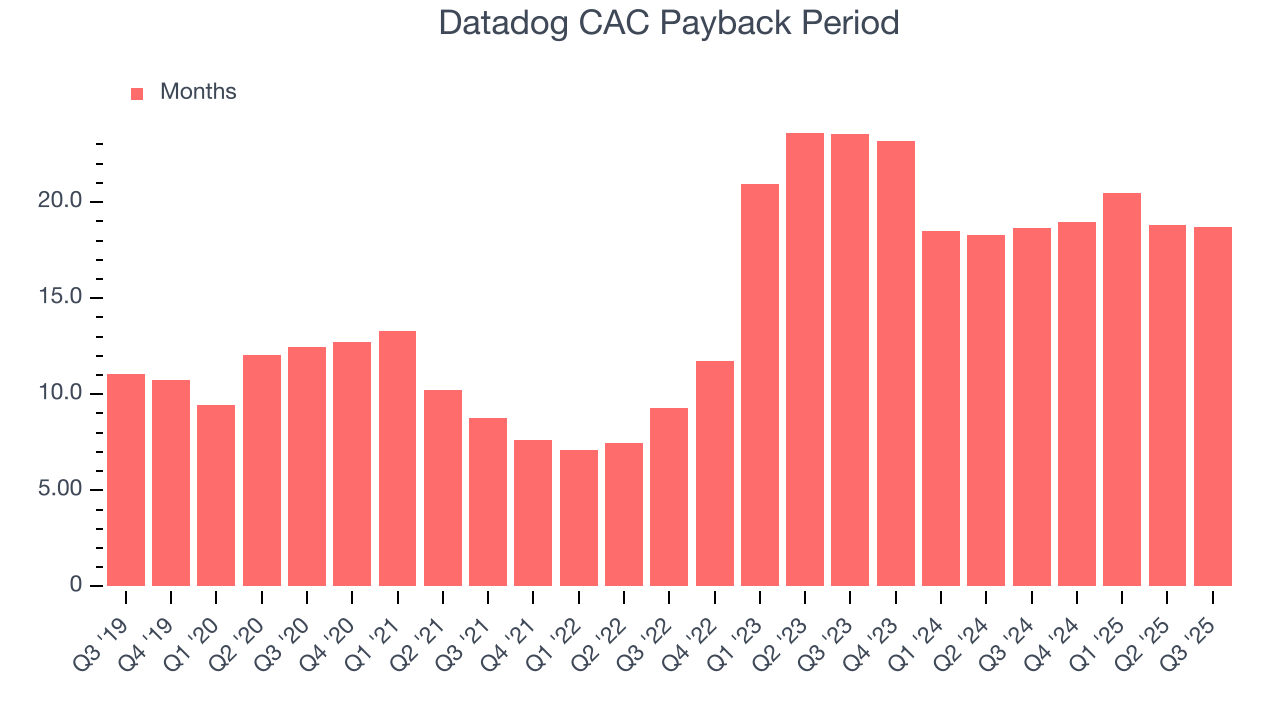
9. Gross Margin & Pricing Power
What makes the software-as-a-service model so attractive is that once the software is developed, it usually doesn’t cost much to provide it as an ongoing service. These minimal costs can include servers, licenses, and certain personnel.
Datadog’s robust unit economics are better than the broader software industry, an output of its asset-lite business model and pricing power. They also enable the company to fund large investments in new products and sales during periods of rapid growth to achieve outsized profits at scale. As you can see below, it averaged an excellent 80% gross margin over the last year. That means Datadog only paid its providers $20.05 for every $100 in revenue.
The market not only cares about gross margin levels but also how they change over time because expansion creates firepower for profitability and free cash generation. Datadog has seen gross margins decline by 0.1 percentage points over the last 2 year, which is slightly worse than average for software.

Datadog produced a 80.1% gross profit margin in Q3, in line with the same quarter last year. Zooming out, Datadog’s full-year margin has been trending down over the past 12 months, decreasing by 1.3 percentage points. If this move continues, it could suggest a more competitive environment with some pressure to lower prices and higher input costs.
10. Operating Margin
Although Datadog broke even this quarter from an operational perspective, it’s generally struggled over a longer time period. Its expensive cost structure has contributed to an average operating margin of negative 1.4% over the last year. Unprofitable, high-growth software companies require extra attention because they spend heaps of money to capture market share. This happened because the company spent loads of money to capture market share. As seen in its fast revenue growth, the aggressive strategy has paid off so far, and Wall Street’s estimates suggest the party will continue. We tend to agree and believe the business has a good chance of reaching profitability upon scale.
Looking at the trend in its profitability, Datadog’s operating margin decreased by 4.2 percentage points over the last two years. This raises questions about the company’s expense base because its revenue growth should have given it leverage on its fixed costs, resulting in better economies of scale and profitability. Datadog’s performance was poor no matter how you look at it - it shows that costs were rising and it couldn’t pass them onto its customers.
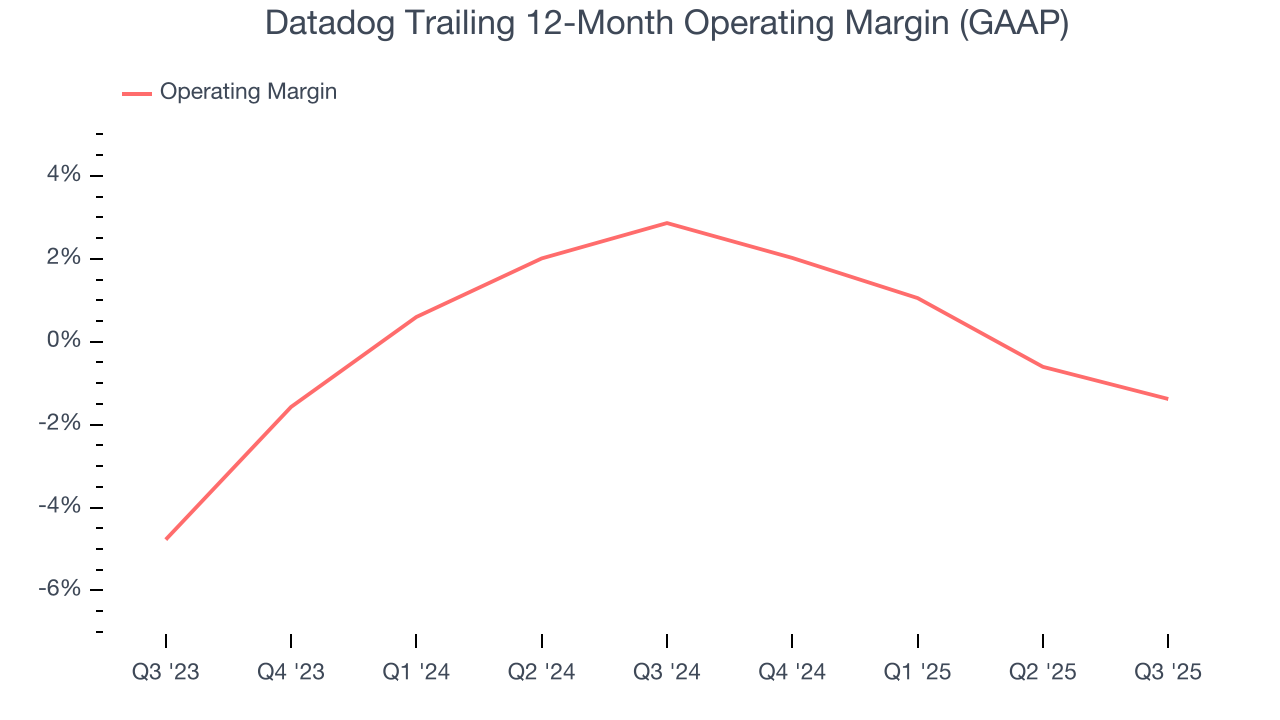
Datadog’s operating margin was negative 0.7% this quarter.
11. Cash Is King
Although earnings are undoubtedly valuable for assessing company performance, we believe cash is king because you can’t use accounting profits to pay the bills.
Datadog has shown robust cash profitability, driven by its attractive business model and cost-effective customer acquisition strategy that enable it to invest in new products and services rather than sales and marketing. The company’s free cash flow margin averaged 26.9% over the last year, quite impressive for a software business. The divergence from its underwhelming operating margin stems from the add-back of non-cash charges like depreciation and stock-based compensation. GAAP operating profit expenses these line items, but free cash flow does not.
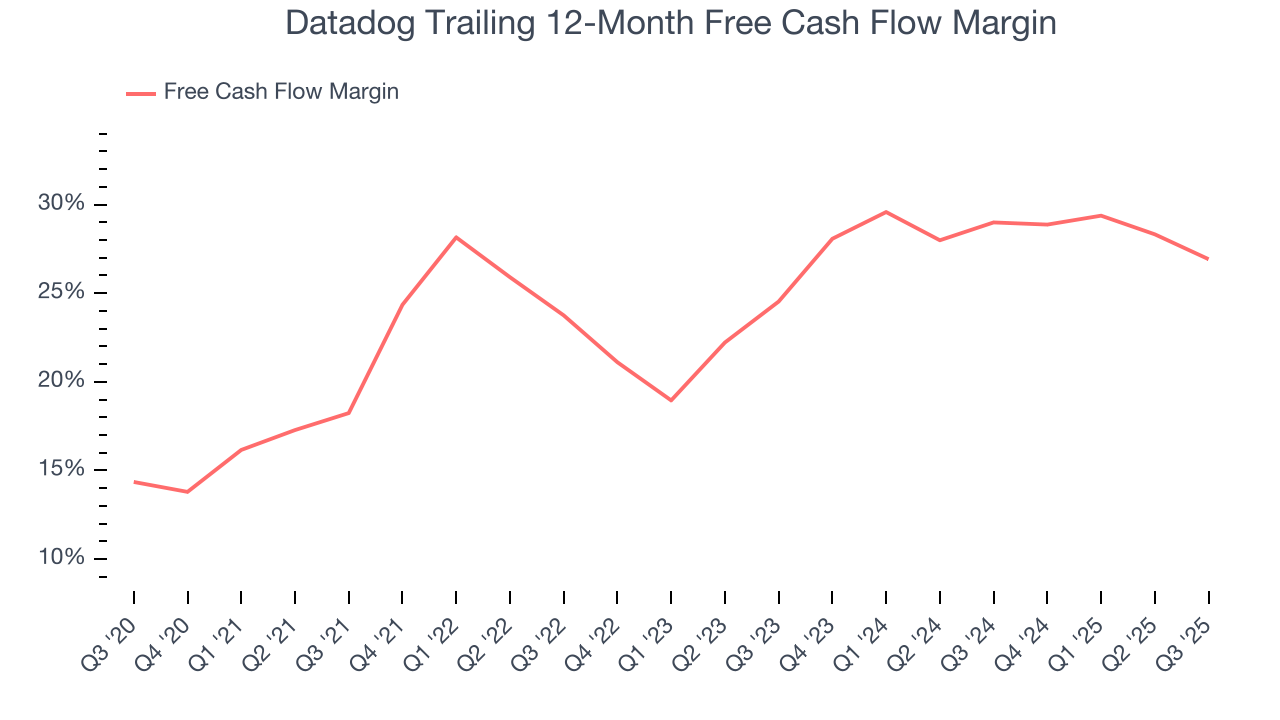
Datadog’s free cash flow clocked in at $214 million in Q3, equivalent to a 24.2% margin. The company’s cash profitability regressed as it was 5.3 percentage points lower than in the same quarter last year, but we wouldn’t put too much weight on the short term because investment needs can be seasonal, causing temporary swings. Long-term trends are more important.
Over the next year, analysts predict Datadog’s cash conversion will fall. Their consensus estimates imply its free cash flow margin of 26.9% for the last 12 months will decrease to 25.4%.
12. Balance Sheet Assessment
One of the best ways to mitigate bankruptcy risk is to hold more cash than debt.
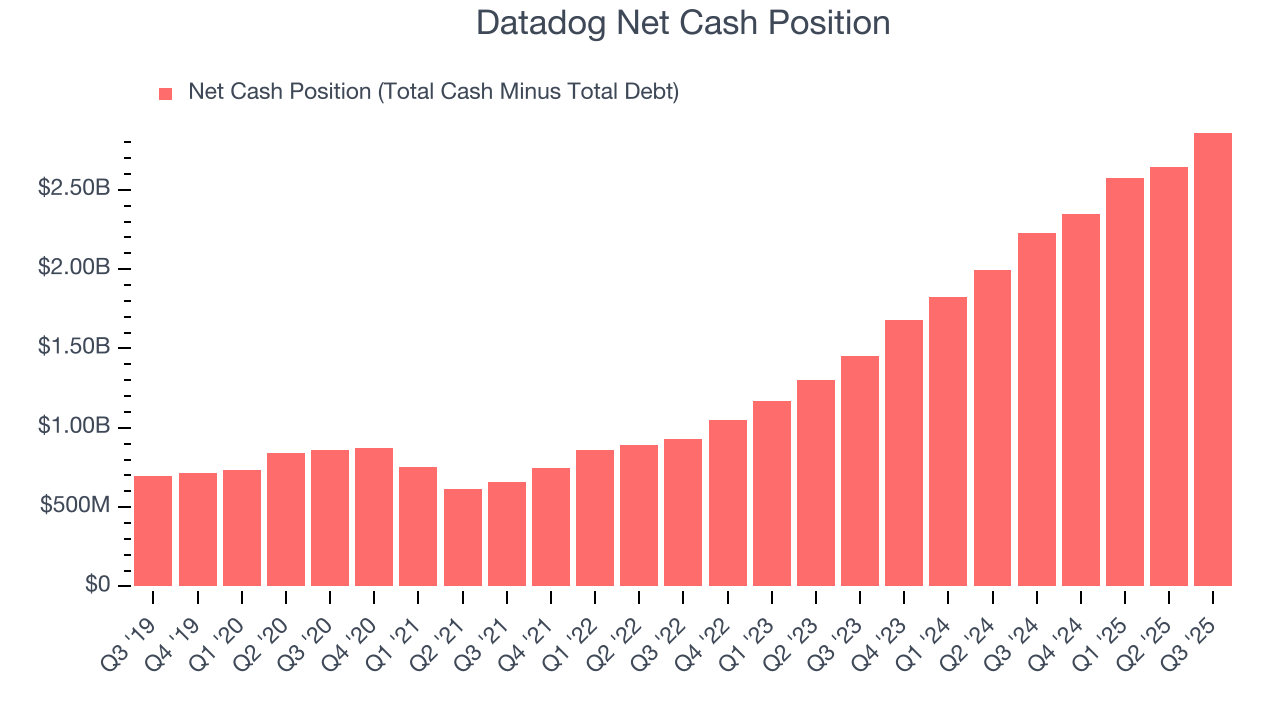
Datadog is a well-capitalized company with $4.14 billion of cash and $1.28 billion of debt on its balance sheet. This $2.86 billion net cash position is 4.3% of its market cap and gives it the freedom to borrow money, return capital to shareholders, or invest in growth initiatives. Leverage is not an issue here.
13. Key Takeaways from Datadog’s Q3 Results
We were impressed by Datadog’s optimistic EPS guidance for next quarter, which blew past analysts’ expectations. We were also glad it had many new large contract wins. Zooming out, we think this was a good print with some key areas of upside. The stock traded up 9.4% to $169.62 immediately following the results.
14. Is Now The Time To Buy Datadog?
Updated: December 4, 2025 at 9:15 PM EST
Before making an investment decision, investors should account for Datadog’s business fundamentals and valuation in addition to what happened in the latest quarter.
There is a lot to like about Datadog. First of all, the company’s revenue growth was exceptional over the last five years. And while its declining operating margin shows it’s becoming less efficient at building and selling its software, its surging ARR shows its fundamentals and revenue predictability are improving. On top of that, Datadog’s efficient sales strategy allows it to target and onboard new users at scale.
Datadog’s price-to-sales ratio based on the next 12 months is 14.4x. Analyzing the software landscape today, Datadog’s positive attributes shine bright. We think it’s one of the best businesses in our coverage and like the stock at this price.
Wall Street analysts have a consensus one-year price target of $211.97 on the company (compared to the current share price of $153.11), implying they see 38.4% upside in buying Datadog in the short term.











